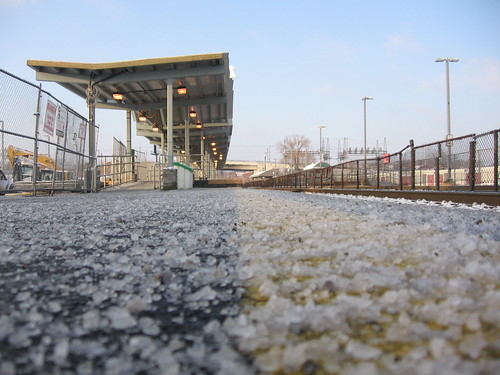
That’s not snow in this picture of the Danforth GO train platform — it’s all salt. My wife took this photo on New Year’s Eve (well, the morning thereof), shortly after a snowfall.
The ramp from Main Street down to the GO station is heated, I assume, because it was completely cleared — a welcome relief for my wife and me, as we’re both frustrated by the lack of proper snow removal on sidewalks this winter.
In a way, my frustration makes me wonder if I should complain about excessive salt at all. Have I suddenly become a civic crankpot? Surely, though, less salt would have done the job on the platform pictured above. Ice and snow on walkways is a problem, yes, but this is not the solution. As Dale Duncan wrote in issue 8 of Spacing:
Too much salt in the ecosystem is about as devastating to our environment as eating French fries day after day is to our bodies. In 2001, the federal government released a report deeming road salt environmentally toxic. It may keep cars from slipping all over the road by lowering the freezing point of water, but it also seeps into our water table, dehydrates our trees, and poisons our wildlife and aquatic life. What’s more, it causes costly damage to our infrastructure, corroding our roadways, sidewalks, and vehicles.
photo by Virginia Dimoglou




20 comments
Solar/geothermal heating of tarmac platforms might be possible – maybe even with enough left over to heat benches for waiting passengers 🙂
For the record, I’ve noted the same overuse of salt at other GO stations too.
When the temperature gets cold enough, walking on this carpet of salt is like walking on ball bearings. I have actually slipped on the salt and fell.
Salt doesn’t do much for cars either. It’s just one of those bad ideas that no ever got around to fixing.
What do those ever-progressive Scandinavians do about snow? They’re also known for their winters.
Makes me think fondly of my time living in Montreal. Sure, the sand they use doesn’t make the walk to work completely without danger, but they plow the sidewalks more often. We could learn a thing or two from their near fanatical approach to rapid snow removal. I only lived there for 1 1/2 winters, but I was always impressed with their system.
Too much salt results in people like you and me grumbling. A little bit of ice results in people slipping, falling, and and most importantly, suing.
It’s just that salt is the quick-and-easy solution to the ice & lawsuit problem.
Unfortunately it’s a lot easier to show the immediate effect of a few inches of ice than it is prove the harm produced by a sidewalk saturated with salt.
Here’s a great bit about Iceland…it might not be something that works everywhere, but it’s a pretty sweet solution.
Apparently it is just like have hot water heating the floor in your home…the pipes just under the sidewalks and roads, melting the snow when it comes.
from http://geoheat.oit.edu/bulletin/bull17-4/art25.htm
SNOW MELTING
The use of geothermal energy for snow melting has been widespread for the past 10-15 years. This kind of utilization gained popularity when plastic pipes for hot water were introduced in the market. Spent water from the houses, at about 35 °, is commonly used for deicing of sidewalks and parking spaces. During the last few years, the extension of snow melting systems has expanded considerably. The total area now covered by snow melting systems is estimated to be 350,000 m2, of which about 250,000 m2 are in Reykjavik. Extensive rehabilitation of the streets in downtown Reykjavik has been undertaken during the past five years. One improvement was to install snow melting systems, covering an area of 50,000 m2, in the sidewalks and streets. This system is designed for a heat output of 180 W per m2 surface area. The annual energy consumption is of course strongly dependent on the weather conditions. Measurements from Reykjavik’s center has shown the energy consumption to be 250 kWh/m2-375 kWh/m2 (Jà ³nsson, 1994). The total energy use for snow melting is estimated to be 380 TJ per year.
Can only imagine if Toronto created a system like Iceland.
We’d have all these bits of tube sticking out of the sidewalk spraying water everywhere from the sidewalks being ripped up and never properly repaired.
They would probably just cut it up, fix their problem and then cover it up with some crap for a while until water builds up creating geysers all over the city.
Then some councillor would probably rave about it and how it makes us world class with all these beautiful geysers everywhere..
Is the salt overkill a manifestation of the War on Winter declared by (thankfully, ex-)Mayor Mel back when?
Seriously, has anyone ever heard of shovels and brooms?
Yes, the asalt on the environment by salt is bad, and a lot can be done to avoid use eg. proper, (not always so prompt) clearing – often best done by some adjacent person or business and not always unionized/contracted staff person, who are needed to operate machinery all through the suburbs because somehow our city sidewalks are often too narrow for such things.
Iceland has a Lot of extra geothermal energy, so that geothermal can’t be replicated here. If we could get the waste heat from the cars captured, then applied…
I miss the beach like snow/ice control used in Edmonton. Your pant cuffs were always gritty and dirty but you didn’t fall on your head. And for the most part sand is not harmful to the rivers and lakes as copious salt application.
This topic infuriates me soooooooo much. To believe that there are no regulations on how much salt is put on our roads.
My friends have caught on to my frustration and say things like “here he goes” when I start talking about it so my reflexes are kicking in and I’ll stop here, but man oh man, it really pisses me off to no end….
(feels like an appropriate ending)
Sweeping the snow from the train platforms and not using salt is great until the next VIA train goes blasting through and all the snow that it kicks up gets blown on to the platform and covers it again. Maybe GO uses salt like no tomorrow because other de-icers which may not be as harmful (I don’t know if they are or not) are probably a lot more expensive than salt. Most of the downtown office towers don’t use salt, they use alternative de-icers which probably don’t damage the granite pavement around the buildings the way salt would. As long as salt is much cheaper than the alternatives, it’ll be used.
It seems salt is only effective within a very narrow temperature band.
I suspect GO uses salt like no tomorrow because when they get hit with a slip-and-fall lawsuit, it’s a great defense.
“Look your honour, could there BE any more salt on GO property?”
Get rid of unions, eliminate work rules, and pay maintenance workers an appropriate wage (i.e. low), and you could do this. But salt works because it saves repeated maintenance. Salt once, and a few little flurries are taken care of, as are the freeze thaw cycles that would otherwise see reappearing ice puddles.
More real world experience, less whining, and an actual focus on solutions rather than political posturing would vastly improve Spacing.
“Get rid of unions, eliminate work rules, and pay maintenance workers an appropriate wage (i.e. low),….less whining, and an actual focus on solutions rather than political posturing would vastly improve Spacing.”
Excuse me?!?!?!?
I think the nameless “Hey” wants to read the Sun or Western Standard.
It seems that this Hey could be exercising the braying cells, as there are actually some real-world problems beyond mere environmental ones with over-salting eg. how the costly infrastructure can be ##^&*9ed some with the over-salting, though it’s good in some ways. It’s part of a problem of how to introduce limits on usage and consumption ahead of total meltdown. And yes, to be fair, sometimes unions aren’t always as helpful to the common good as one might think.
Cities on the Praries have phased out Salt usage. They claim it is too cold for Salt to be used on the Praries.
The most common and most effective opition is Sand. The cities just cover the road with Sand. In Calgary we use gravel – which means a lot of cracked windshields in the Spring.
From what I have seen, Salt doesn’t work as well as Sand or Gravel. Sand and Gravel create traction for peoples tires and feet. Salt will melt the ice, but only if it warm enough. I don’t think most Canadian Winters are that warm.
Phasing out Salt seems to make sense to me, it’s better for our Cars (no rust and better traction with Sand), for our roads (less maintence required) and for the environment. But I suspect people have become to confortable with Salt and they are not willing to let it go.
A little “pepper”-like sand would be good, along with the leftover “herb”s-like leaves mixed with the organics that spill from the green-bin garbage pick=ups.
This doesn’t totally relate, but I’ve seen some snow covered streets that are really disgraceful. Check it out:
http://prototype.thmvmnt.com/archives/39